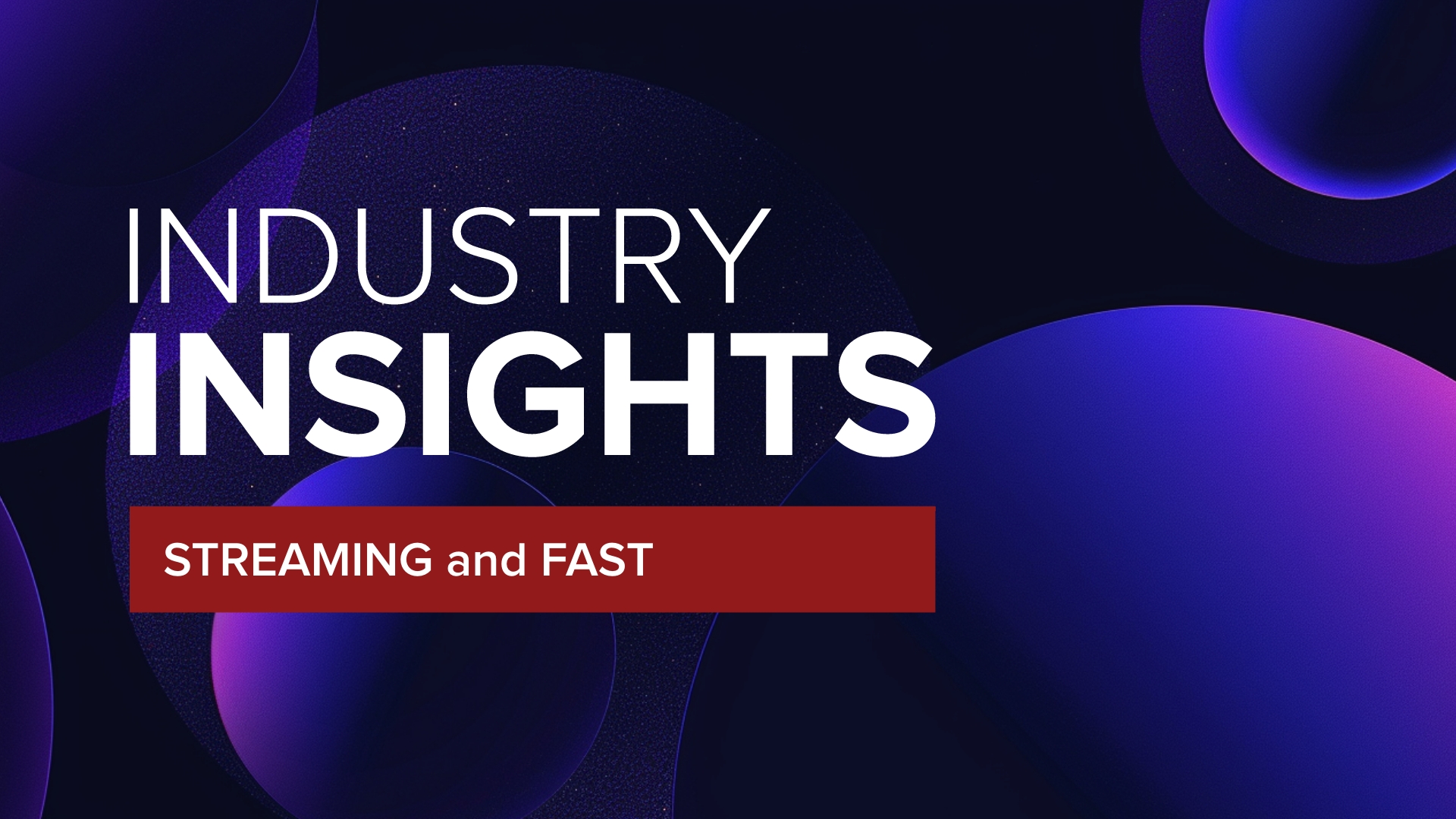Industry Insights: Monetization strategies shaping the FAST platform landscape

Subscribe to NCS for the latest news, project case studies and product announcements in broadcast technology, creative design and engineering delivered to your inbox.
In the conclusion of our Industry Insights roundtable on free ad-supported streaming television, the discussion delves into the intricacies of advertising trends, monetization models and the long-term viability of FAST platforms.
Experts across the broadcast sector weigh in on the shift towards streaming advertising models, the significance of ad personalization, and the innovative strategies enabling more effective viewer engagement. As the FAST landscape continues to mature, understanding these dynamics is crucial for stakeholders looking to navigate the complexities of digital broadcasting and advertising.
Key takeaways from the Industry Insights roundtable
- Ad personalization and data-driven targeting are increasing, allowing more relevant, less disruptive ads on FAST platforms.
- Partnerships with content creators and bundling with other services provide opportunities to harden ad rates and grow audiences.
- Flexible monetization models like content syndication and ad revenue sharing help media companies capitalize on their libraries.
- Maintaining engagement via personalized experiences and niche content is key to FAST’s viability alongside advertiser interest.
- Evolution of platform-as-a-service models will likely broaden FAST services as premium content providers embrace it.
What are the evolving trends in advertising within FAST platforms?
Yoann Hinard, COO, Witbe: While ad personalization is undoubtedly important, attempting to do it for each individual user may be impractical. Ad personalization by population is progressing alongside the per-user targeting, which helps FAST providers scale successfully.
Paolo Cuttorelli, SVP of global sales, Evergent: We’re seeing a shift away from linear, traditional advertising toward a streaming advertising model in which the household TV is serving as a portal into streaming services. Leveraging advanced user data, such as viewing habits and platform transactions, means that media companies can enable more relevant, targeted advertising experiences. This not only enhances viewer engagement but also increases the value proposition for advertisers seeking more effective ways to reach TV audiences.
Gatis Gailis, CEO, Veset: Solutions such as in-video ad-insertion, and personalized, targeted ads among others allows for advertising to complement the development of FAST channels. As a result, advertising spaces in FAST channels are becoming more valuable in association with the content being broadcast. In this new era of FAST advertising, monetization hails as king with consumer habits dominating the ad landscape, relying on changing consumer behaviour to deliver successful and well-received advertisements.
Anupama Anantharaman, VP of product management, Interra: The FAST landscape is characterized by a focus on innovation in ad insertion, delivery, and measurement. As a result, there is a rising emphasis on tools that offer ad analytics, targeted advertisements, and technologies that enhance the efficiency of targeted and dynamic ad insertion processes. These trends underscore a dynamic shift towards personalized and data-driven advertising strategies within FAST platforms.
Thomas Kramer, VP of strategy, MainConcept: With the growth of FAST channels, providers are experimenting with the best and least intrusive ways to deliver ads that, like the content, are personalized to the viewer. The potential of targeting ads to the viewer depends on several factors; how they are delivered (server-side ad insertion versus client-side ad insertion), the type of personal information available, and the variety of ads. Other trends such as AI used for content search is likely to be increasingly used in ad insertion and how the ads feature alongside the content to minimize interrupted viewing.
Dave Dembowski, SVP of global sales, Operative: Because FAST is digital, it can be bought and sold programmatically, support interactivity, and enable enhanced targeting. All of these trends are new on FAST but well established on other digital channels. We will see FAST adapt to these trends and likely evolve further — perhaps enabling things like social shopping right in the app on TV.
Srini KA, co-founder and CRO, Amagi: Contextual targeting especially powered by enriched metadata is being well adopted in downstream adtech ecosystem. Such metadata passback by an SSAI provider can improve the CPM for FAST channels. A recent survey by XUMO & FASTMaster also echoes increased interest from ad buyers for FAST inventory. Innovative ad formats such as overlays, and in-content ads are being tested.
What monetization models are proving most successful for FAST platforms?
Medhat Ali, director, VM Cloud: By definition, FAST is primarily advertising-funded, but that can and should include closely targeted advertising. What is important is that FAST channels as part of a broader broadcast and streaming operation must harden advertising rates, and offer the same protected, curated commercial environment as legacy channels. FAST also gives operators opportunities for partnerships with content creators, and bundling it with other services.
Venugopal Iyengar, COO for digital, Planetcast: One of the best uses of FAST that we’ve seen has been to use it as a platform for expanding international reach. India is extremely prolific across film and TV, and a lot of its growing international popularity can be attributed to the availability of FAST. New content offerings have a better chance of gaining traction when they’re free, and media companies are making full use of this to expand their global reach and monetization.
Greg Morrow, GM of ViewNexa, Bitcentral: As the market continues to converge, we will see more monetization opportunities. The media companies that can take advantage of flexible business models for FAST channels, such as content syndication, ad revenue, or inventory share, will be the most successful. To make these models possible, media companies need to integrate the right technology that will give them the capabilities and flexibility to utilize their content libraries in this way to fuel revenue streams that were previously out of their reach.
How are FAST platforms leveraging personalization to enhance viewer experience?
Ahmed Swidan, director, Ateme: With the same content available on several FAST platforms, the focus for differentiation is now on innovative features such as personalization. FAST platforms can collect a wealth of first-party data and use it to personalize both the service offering and the way content is presented to viewers. The ultimate personalization is personal FAST channels.
Yoann Hinard, COO, Witbe: FAST channels personalize ads to the viewer’s preferences, which is nothing new. However, they also personalize ad pod sequences — and their frequency — based on the channel a viewer was previously watching, not just the one they’re currently on. This technology delivers a major advantage over the legacy broadcasting approach (which FAST is invoking) by reducing viewer fatigue and maintaining high engagement.
Olivier Karra, marketing director, Broadpeak: Streaming content that users like and is available at all times is a key factor to boost quality of experience. Today, virtual channels with an unlimited number of audiences and variants are leveraging dynamic schedules provisioned with recommendation engine technology to enable cost-effective personalization at scale. Ultimately, providing a personalized FAST channel service is going to be a game changer for the most advanced streaming platforms.
John Wastcoat, SVP of business development, Zixi: FAST platforms are utilizing IP delivery, driven by user metadata, as a foundational element to provide personalized content. Additionally, the introduction of innovative technologies like HTML graphics overlays and direct-to-player overlays enhances the overall user experience, creating possibilities for new approaches in delivering ads, interactive experiences, and opportunities related to betting. This marks a significant evolution in content delivery methods, allowing for a more tailored and engaging viewing experience.
Thomas Kramer, VP of strategy, MainConcept: With many FAST platforms, it is not necessary for the viewer to login or even enter personal data. While this is potentially attractive to the viewer, for vendors it reduces the data they have access to, and so personalization is limited to a viewer’s IP location or browser history. For users that are willing to share personal data or even create an account with a FAST channel they open a world of personalization and enhanced features from storing favorites to reacting to viewed content, all of which gives the platform much more data to leverage personalization to enhance viewer experience.
Dave Dembowski, SVP of global sales, Operative: For advertisers, personalization is about delivering the right message to the right audience, and FAST enables that with targeting and dynamic ad insertion. On a FAST channel, advertisers can target audience segments and then use household-level or even app-user level data to send a relevant advertisement.
Rick Young, SVP and head of global products, LTN: We all know that ads can be programmatically inserted to reach very individual viewers once they are consuming a channel. The trick is to attract those consumers in the first place. We are seeing personalization on FAST channels mainly focused on delivering city, regional or country specific like programming like news and sports.
Srini KA, co-founder and CRO, Amagi: An SVOD-like experience is being experimented with by different FAST platforms to surface the right channels based on the audience profile. While we are starting to see profile management in FAST platforms, Amagi has been at the forefront of partnering with FAST platforms in personalizing viewer experience with capabilities such as personalized channel line-up, AI-generated channel content based on viewing interests, and less-obtrusive targeted ads such as in-content advertising.
Is the FAST business model sustainable in the long term?
Olivier Karra, marketing director, Broadpeak: For challenging markets with limited audiences, cost reduction is a matter of survival. Leveraging new and cost-effective ways to generate FAST channels will be essential. We see cost-cutting technologies such as virtual channel playout and automated schedule generation gaining significant momentum this year.
Paolo Cuttorelli, SVP of global sales, Evergent: The long-term viability of the FAST model hinges on its ability to continuously attract and monetize viewers while maintaining advertiser interest. Media and sports brands are responding to this challenge by offering a diverse range of niche content for dedicated audiences that make up a compelling proposition for advertisers. Consumers will always be interested in free-to-access, relevant content — the challenge is keeping them engaged with personalized, intuitive experiences that unlock wider monetization avenues.
Paul Briscoe, chief architect, TAG Video Systems: FAST is sustainable as long as the model of scheduled linear programming with interstitial advertising remains healthy. Whether this is likely remains unclear, there is definitely a legacy audience with an expectation of this mode of consumption, but the under-50s and below mostly understand that TV can be so much more thanks to the internet and OTT. Whether this audience evolves to the traditional linear viewing model will drive the revenue needed for long-term viability.
Allan Nicholson, head of advertising solutions, Harmonic: At Harmonic, we anticipate the evolution of current platform as a service (PaaS) models as an increasing number of premium content providers embrace FAST as their preferred delivery method. These content owners are confident in their ability to maximize content monetization by drawing on insights gained from past broadcast experiences. This shift will broaden FAST services beyond a limited number of niche players and draw in technology vendors that have a proven track record in delivering broadcast reliability, video quality, and an enhanced user experience through streaming services for tier-one platforms.
Explore more from this roundtable
Subscribe to NCS for the latest news, project case studies and product announcements in broadcast technology, creative design and engineering delivered to your inbox.







tags
Ahmed Swidan, Allan Nicholson, Amagi, Anupama Anantharaman, ATEME, Bitcentral, Broadpeak, Dave Dembowski, Evergent, Free Ad-Supported Streaming Television (FAST), Gatis Gailis, Greg Morrow, Harmonic, Interra Systems, John Wastcoat, KA Srinivasan, LTN, MainConcept, Medhat Ali, Olivier Karra, Operative, Paolo Cuttorelli, Paul Briscoe, Planetcast International, Rick Young, TAG Video Systems, Thomas Kramer, Venugopal Iyengar, Veset, VM Cloud, Witbe, Yoann Hinard, Zixi
categories
Featured, Industry Insights, Streaming, Voices